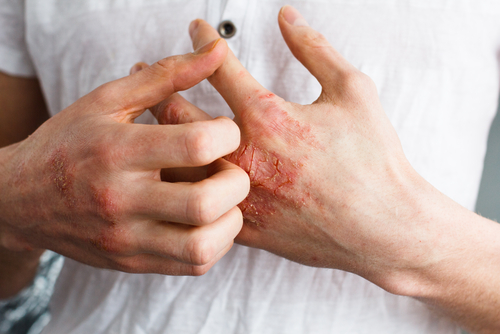
Feel healthy and beautiful in your own skin
Eczema Dermatitis Treatment in Seattle WA
Eczema and dermatitis are similar terms used to describe an itchy rash with inflamed skin. Symptoms can range in severity from mild itching and redness to severe blistering and cracked skin. There are many types of dermatoses that may be categorized by the following:
 the location of the rash. For instance, dermatitis on the hands that may be referred to as “hand eczema”
the location of the rash. For instance, dermatitis on the hands that may be referred to as “hand eczema”- the appearance of the rash. For instance the term “discoid eczema” describes a type of eczema with coin-shaped lesions.
- the underlying cause of the rash. For instance, allergic contact dermatitis is due to the skin coming into contact with something that triggers an allergic response.
Types Of Eczema
Some of the most common forms of dermatitis (eczema) include the following:
Atopic dermatitis: Atopic dermatitis is the most common form of eczema. It describes the dry, sensitive skin associated with allergies and asthma that tends to be inherited. It is common in infants and toddlers who may “grow out of it” by school age. Moderate-to-severe cases require ongoing treatment and appropriate skincare to prevent flare-ups.
Asteatotic dermatitis: This form of dermatitis is caused by dry skin, particularly on the lower legs of elderly people. This is due to a reduction in sebum, the natural oil in skin that normally protects and moisturizes the skin.
Contact dermatitis: Contact dermatitis is a localized skin reaction to an allergen or irritant, causing redness, inflammation, and intense itching.
Dyshidrotic dermatitis: Dyshidrotic eczema, also called pompholyx or vesicular hand/foot dermatitis, causes small, intensely itchy blisters to form on the palms of the hands or soles of the feet.
Nummular dermatitis: Nummular eczema is identifiable by coin-shaped patches of irritated skin, occurring sometimes after a skin injury or insect bite.
Seborrheic dermatitis: Seborrheic dermatitis is sometimes called “cradle cap” in newborns. This rash often appears on the scalp, behind the ears, or on the face, and it is identifiable by waxy, yellowish, scaly patches of skin.
Stasis dermatitis: This shows up as red, irritated skin on the lower legs and is often associated with circulation problems.
Acute Eczema vs. Chronic Eczema
Dermatitis can be short-term (acute) or long-term (chronic). Acute dermatitis usually appears as a red rash, which may be blistered or swollen. When the dermatitis becomes chronic, the skin may become thickened, rough, and darker than the surrounding skin due to prolonged scratching.
Schedule An Eczema Treatment Consultation
If you are experiencing n itchy rash with inflamed skin and are ready to do something about it, please contact Advanced Dermatology and Laser Institute of Seattle at 206-402-4797. Dr. Steven Greene is a board-certified dermatologist who has helped numerous patients get treatment for their eczema.
Read what our patients are saying!
As a thirty year old, I’m beginning to notice traits about my skin that are aging me–large pores, laxity, mild acne scarring, and uneven tone to name only a few. Three factors have prevented me from undergoing a laser skin resurfacing treatment: cost, pain, and down-time. After a lot of research, I finally found a laser treatment that is not only affordable, but it was pain free (no numbing cream required!), and entails ZERO down-time…I had a date on the same day as my treatment! This too-good-to-be-true combination made me skeptical of its effectiveness, but after one treatment with the LASER GENESIS, my skin appeared brighter, tighter, and smoother! I walked into Advanced Dermatology and Laser Institute of Seattle over my lunch break (which is an hour) and left the treatment with thirty minutes to spare. Dr. Greene took his time to listen to my concerns during my initial consult and he customized a plan that checked every box! I was recommended to undergo a series of four treatments total with the LASER GENESIS and I’m looking forward to more results!
